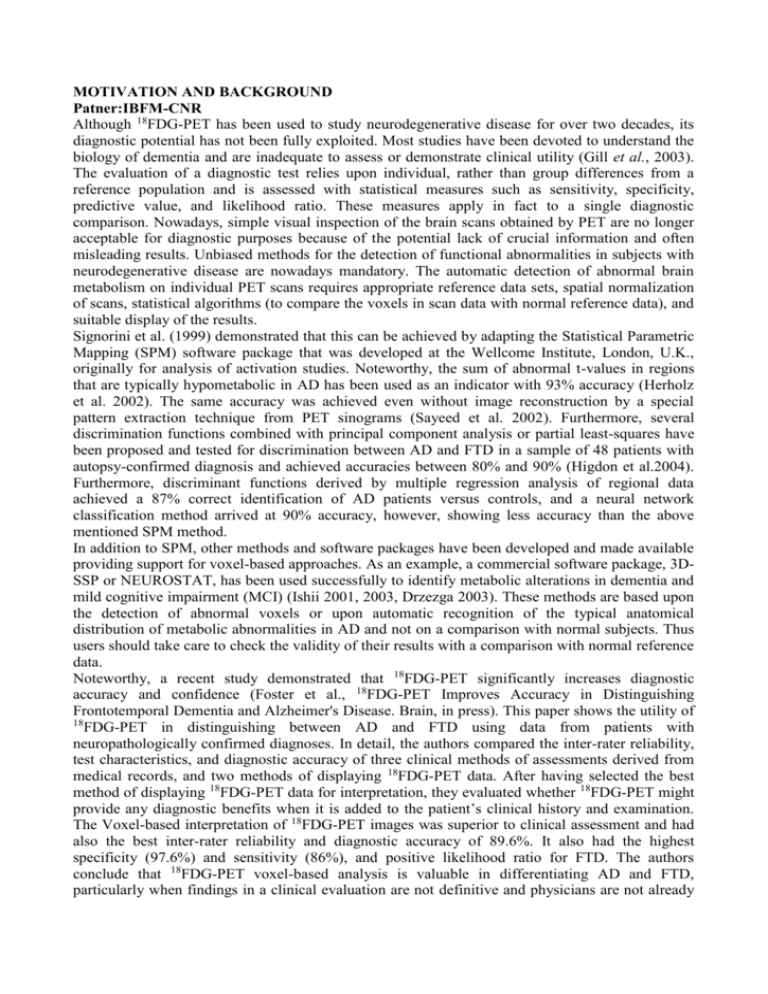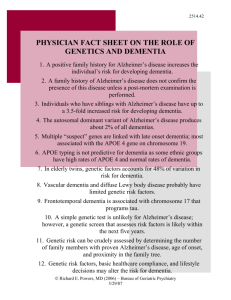MOTIVATION AND BACKGROUND
advertisement

MOTIVATION AND BACKGROUND Patner:IBFM-CNR Although 18FDG-PET has been used to study neurodegenerative disease for over two decades, its diagnostic potential has not been fully exploited. Most studies have been devoted to understand the biology of dementia and are inadequate to assess or demonstrate clinical utility (Gill et al., 2003). The evaluation of a diagnostic test relies upon individual, rather than group differences from a reference population and is assessed with statistical measures such as sensitivity, specificity, predictive value, and likelihood ratio. These measures apply in fact to a single diagnostic comparison. Nowadays, simple visual inspection of the brain scans obtained by PET are no longer acceptable for diagnostic purposes because of the potential lack of crucial information and often misleading results. Unbiased methods for the detection of functional abnormalities in subjects with neurodegenerative disease are nowadays mandatory. The automatic detection of abnormal brain metabolism on individual PET scans requires appropriate reference data sets, spatial normalization of scans, statistical algorithms (to compare the voxels in scan data with normal reference data), and suitable display of the results. Signorini et al. (1999) demonstrated that this can be achieved by adapting the Statistical Parametric Mapping (SPM) software package that was developed at the Wellcome Institute, London, U.K., originally for analysis of activation studies. Noteworthy, the sum of abnormal t-values in regions that are typically hypometabolic in AD has been used as an indicator with 93% accuracy (Herholz et al. 2002). The same accuracy was achieved even without image reconstruction by a special pattern extraction technique from PET sinograms (Sayeed et al. 2002). Furthermore, several discrimination functions combined with principal component analysis or partial least-squares have been proposed and tested for discrimination between AD and FTD in a sample of 48 patients with autopsy-confirmed diagnosis and achieved accuracies between 80% and 90% (Higdon et al.2004). Furthermore, discriminant functions derived by multiple regression analysis of regional data achieved a 87% correct identification of AD patients versus controls, and a neural network classification method arrived at 90% accuracy, however, showing less accuracy than the above mentioned SPM method. In addition to SPM, other methods and software packages have been developed and made available providing support for voxel-based approaches. As an example, a commercial software package, 3DSSP or NEUROSTAT, has been used successfully to identify metabolic alterations in dementia and mild cognitive impairment (MCI) (Ishii 2001, 2003, Drzezga 2003). These methods are based upon the detection of abnormal voxels or upon automatic recognition of the typical anatomical distribution of metabolic abnormalities in AD and not on a comparison with normal subjects. Thus users should take care to check the validity of their results with a comparison with normal reference data. Noteworthy, a recent study demonstrated that 18FDG-PET significantly increases diagnostic accuracy and confidence (Foster et al., 18FDG-PET Improves Accuracy in Distinguishing Frontotemporal Dementia and Alzheimer's Disease. Brain, in press). This paper shows the utility of 18 FDG-PET in distinguishing between AD and FTD using data from patients with neuropathologically confirmed diagnoses. In detail, the authors compared the inter-rater reliability, test characteristics, and diagnostic accuracy of three clinical methods of assessments derived from medical records, and two methods of displaying 18FDG-PET data. After having selected the best method of displaying 18FDG-PET data for interpretation, they evaluated whether 18FDG-PET might provide any diagnostic benefits when it is added to the patient’s clinical history and examination. The Voxel-based interpretation of 18FDG-PET images was superior to clinical assessment and had also the best inter-rater reliability and diagnostic accuracy of 89.6%. It also had the highest specificity (97.6%) and sensitivity (86%), and positive likelihood ratio for FTD. The authors conclude that 18FDG-PET voxel-based analysis is valuable in differentiating AD and FTD, particularly when findings in a clinical evaluation are not definitive and physicians are not already highly confident with their clinical diagnosis. This work demonstrates the addition of 18FDG-PET to clinical summaries to increase diagnostic accuracy and confidence for both AD and FTD. 1. Chui H, Zhang Q. Evaluation of dementia: a systematic study of the usefulness of the American Academy of Neurology’s practise parameters. Neurology 1997;49:925. 2. Corey-Bloom J, Thal LJ, Galasko D, Folstein M, Drachman D, Raskind M, Lanska DJ. Diagnosis and evaluation of dementia. Neurology 1995;45:211-218. 3. Scheltens P. Early diagnosis of dementia: neuroimaging. Journal of Neurology 1999;246:16. 4. Pullicino P, Benedict RHB, et al. Neuroimaging criteria for vascular dementia. Archives of Neurology 1996;723. 5. Frisoni G and Filippini N. Quantitative and Functional Magnetic Resonance Imaging Techniques. In: The Dementias. K Herholz, D Perani and C Morris eds. Taylor and Francis 2006, pages:157-195. 6. Minoshima S, Giordani B, Berent S, Frey KA, Foster NL, Kuhl DE (1997) Metabolic reduction in the posterior cingulate cortex in very early Alzheimer's disease. Annals of Neurology 42:85-94. 7. Anchisi D, Borroni B, Franceschi M, Kerrouche N, Kalbe E, Beuthien-Beumann B, Cappa S, Lenz O, Ludecke S, Marconi A, Mielke R, Ortelli P, Padovani A, Pelati O, Pupi A, Scarpini E, Weisenbach S, Herholz K, Salmon E, Holthoff V, Sorbi S, Fazio F, Perani D. Heterogeneity of glucose brain metabolism in Mild Cognitive impariment predicts clinical progression to Alzheimer’s disease. Arch Neurol-Chicago, 2005; 62: 1728-1733. 8. Mosconi L, Perani D, Sorbi S, Herholz K, Nacmias B, Holthoff V, Salmon E, Baron JC, De Cristofaro MTR, Padovani A, Borroni B, Franceschi M, Bracco L, Pupi A, MCI conversion to dementia and the Apoe genotype: a prediction study with FDG-PET. Neurology, 2004; 63 (12):2332-2340. 9. Borroni B, Anchisi D, Paghera B, Vicini B, Kerrouche N, Garibotto V, Terzi A, Vignolo LA, Di Luca M, Giubbini R, Padovani A, Perani D. Combined 99mTc-ECD SPECT and neuropsychological studies in MCI for the assessment of conversion to AD. Neurobiol Aging, 2006; 27: 24-31. 10. Messa C, Perani D, et al. High resolution Technetium-99m-HMPAO SPECT in patients with probable Alzheimer’s disease: comparison with fluorine-18-FDG PET, Journal of Nuclear Medicine 1994;35:210. 11. Herholz K. FDG PET: Imaging Cerebral Glucose Metabolism with Positron Emission Tomography. In: The Dementias. K Herholz, D Perani and C Morris eds. Taylor and Francis 2006, pages: 229-251. 12. Dougall N and Ebmeier KP Perfusion Imaging with Single Photon Emission Computed Tomography. In: The Dementias. K Herholz, D Perani and C Morris eds. Taylor and Francis 2006, pages: 197-228. 13. Frackowiak RSJ, Friston KJ, et al. Human Brain Mapping. San Diego, Academic Press, 2004. 14. Imran MB, Kawashima R, Awata S, Sato K, Kinomura S, Ono S, Sato M, et al. Tc-99m HMPAO SPECT in the evaluation of Alzheimer’s disease: correlation between neuropsychiatric evaluation and CBF images. J Neurol Neurosurg Psychiatry 1999;66: 228-232. 15. Signorini M, Paulesu E, Friston K, Perani D, Lucignani G, Colleluori A, Striano G, et al. Rapid assessment of [18F]FDGPET brain scans in individual patients with Statistical Parametric Mapping. A clinical validation. Neuroimage 1999;9:63-80. 16. Varrone A, Pappatà S, Caracò C, Soricelli A, Milan G,Quarantelli M, Alfano B, Postiglione A, Salvatore M Voxel-based comparison of rCBF SPET images in frontotemporal dementia and Alzheimer’s disease highlights the involvement of different cortical networks. European Journal of Nuclear Medicine 29, 11, 1448.1454, 2002. 17. Ibanez V, Pietrini P, et al. Regional glucose metabolic abnormalities are not the result of atrophy in Alzheimer’s disease. Neurology 1998;50:1585. 18. Herholz K, Salmon E, Perani D, Baron JC, Holthoff V, Frolich L, Schonknecht P, Ito K, Mielke R, Kalbe E, Zundorf G, Delbeuck X, Pelati O, Anchisi D, Fazio F, Kerrouche N, Desgranges B, Eustache F, BeuthienBaumann B, Menzel C, Schroder J, Kato T, Arahata Y, Henze M, Heiss WD (2002) Discrimination between Alzheimer dementia and controls by automated analysis of multicenter FDG PET. Neuroimage 17:302-16. 19. Salmon E, Garraux G, Delbeuck X, Collette F, Kalbe E, Zuendorf G, Perani D, Fazio F, Herholz K (2003) Predominant ventromedial frontopolar metabolic impairment in frontotemporal dementia. Neuroimage 20:435-40. 20. Higdon R, Foster NL, Koeppe RA, DeCarli CS, Jagust WJ, Clark CM, Barbas NR, Arnold SE, Turner RS, Heidebrink JL, Minoshima S (2004) A comparison of classification methods for differentiating frontotemporal dementia from Alzheimer's disease using FDG-PET imaging. Stat Med 23:315-26. 21. Knopman DS, DeKosky ST, Cummings JL, Chui H, Corey-Bloom J, Relkin N, et al. Practice parameter: diagnosis of dementia (an evidence-based review). Report of the Quality Standards Subcommittee of the American Academy of Neurology. Neurology 2001; 56:1143-1153. 22. McKeith et al. Diagnosis and management of dementia with >Lewy bodies. Neurology 65, 1, 2005. 23. Hosaka K, Ishii K, Sakamoto S, et al. Voxel-based comparison of regional cerebral glucose metabolism between PSP and corticobasal degeneration. J Neurol Sci 2002 199:67–71. 24. F Portet, P J Ousset, P J Visser, G B Frisoni, F Nobili, Ph Scheltens, B Vellas, J Touchon, the MCI Working Group of the European Consortium on Alzheimer’s Disease (EADC) Mild cognitive impairment (MCI) in medical practice: a critical review of the concept and new diagnostic procedure. Report of the MCI Working Group of the European Consortium on Alzheimer’s Disease J Neurol Neurosurg Psychiatry 2006;77:714– 718. 25. Tai YF and Piccin P. Application of PET in neurology J Neurol Neurosurg Psychiatry 2004, 75, 669-676. 26. Nobili F, Mignone A, Rossi E, et al. Migraine During Systemic Lupus Erythematosus: Findings from Brain Single Photon Emission Computed Tomography. J Rheumatol 2006;33:2184–91. 27. Asada T, Matsuda H, Morooka T, Nakano S, Kimura M, Uno M. Quantitative single photon emission tomography for the diagnosis of transient global amnesia: adaptation of statistical parametric mapping. Psychiatry Clin Neurosci 2000;54:691-4. 28. Dougall N, Nobili F, Ebmeier KP for the European Commission Framework 4: “SPECT in dementia”, BMH4 98 3130. Predicting the accuracy of a diagnosis of Alzheimer's disease with 99mTc HMPAO single photon emission computed tomography. Psychiatry Res 2004; 131/2:157-168.









